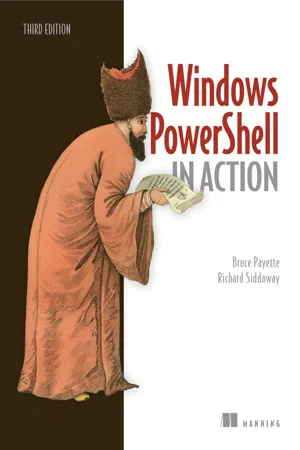
- 904 pages
- English
- ePUB (mobile friendly)
- Available on iOS & Android
Windows PowerShell in Action
About this book
Summary Windows PowerShell in Action, Third Edition is the definitive guide to PowerShell, now revised to cover PowerShell 6.Purchase of the print book includes a free eBook in PDF, Kindle, and ePub formats from Manning Publications. About the Technology In 2006, Windows PowerShell reinvented the way administrators and developers interact with Windows. Today, PowerShell is required knowledge for Windows admins and devs. This powerful, dynamic language provides command-line control of the Windows OS and most Windows servers, such as Exchange and SCCM. And because it's a first-class.NET language, you can build amazing shell scripts and tools without reaching for VB or C#. About the Book Windows PowerShell in Action, Third Edition is the definitive guide to PowerShell, now revised to cover PowerShell 6. Written by language designer Bruce Payette and MVP Richard Siddaway, this rich book offers a crystal-clear introduction to the language along with its essential everyday use cases. Beyond the basics, you'll find detailed examples on deep topics like performance, module architecture, and parallel execution. What's Inside
- The best end-to-end coverage of PowerShell available
- Updated with coverage of PowerShell v6
- PowerShell workflows
- PowerShell classes
- Writing modules and scripts
- Desired State Configuration
- Programming APIs and pipelines
About the Reader Written for intermediate-level developers and administrators. About the Authors Bruce Payette is codesigner and principal author of the Power-Shell language. Richard Siddaway is a longtime PowerShell MVP, author, speaker, and blogger. Table of Contents
- Welcome to PowerShell
- Working with types
- Operators and expressions
- Advanced operators and variables
- Flow control in scripts
- PowerShell functions
- Advanced functions and scripts
- Using and authoring modules
- Module manifests and metadata
- Metaprogramming with scriptblocks and dynamic code
- PowerShell remoting
- PowerShell workflows
- PowerShell Jobs
- Errors and exceptions
- Debugging
- Working with providers, files, and CIM
- Working with.NET and events
- Desired State Configuration
- Classes in PowerShell
- The PowerShell and runspace APIs
- Appendix - PowerShell 6.0 for Windows, Linux, and MacOS
Frequently asked questions
- Essential is ideal for learners and professionals who enjoy exploring a wide range of subjects. Access the Essential Library with 800,000+ trusted titles and best-sellers across business, personal growth, and the humanities. Includes unlimited reading time and Standard Read Aloud voice.
- Complete: Perfect for advanced learners and researchers needing full, unrestricted access. Unlock 1.4M+ books across hundreds of subjects, including academic and specialized titles. The Complete Plan also includes advanced features like Premium Read Aloud and Research Assistant.
Please note we cannot support devices running on iOS 13 and Android 7 or earlier. Learn more about using the app.
Information
Chapter 1. Welcome to PowerShell
- Core concepts
- Aliases and elastic systems
- Parsing and PowerShell
- Pipelines
- Formatting and output
Vizzini: Inconceivable!Inigo: You keep on using that word. I do not think it means what you think it means.William Goldman, The Princess Bride
Note
Note
'Hello world.'
Get-ChildItem -Path $env:windir\*.log | Select-String -List error | Format-Table Path,LineNumber –AutoSize
([xml] [System.Net.WebClient]::new(). DownloadString('http://blogs.msdn.com/powershell/rss.aspx')). RSS.Channel.Item | Format-Table title,link using assembly System.Windows.Forms using namespace System.Windows.Forms $form = [Form] @{ Text = 'My First Form' } $button = [Button] @{ Text = 'Push Me!' Dock = 'Fill' } $button.add_Click{ $form.Close() } $form.Controls.Add($button) $form.ShowDialog() Figure 1.1. When you run the code from the example, this window will be displayed.

The Monad, of which we shall here speak, is nothing but a simple substance, which enters into compounds. By “simple” is meant “without parts.”Gottfried Wilhelm Leibniz, The Monadology (translated by Robert Latta)
1.1. What is PowerShell?
- PowerShell is a command-line shell.
- PowerShell is a scripting environment.
- PowerShell is an automation engine.
Note
1.1.1. Shells, command lines, and scripting languages
Table of contents
- Copyright
- Brief Table of Contents
- Table of Contents
- Praise for the Second Edition
- Praise for the First Edition
- Preface
- Acknowledgments
- About this Book
- About the Cover Illustration
- Chapter 1. Welcome to PowerShell
- Chapter 2. Working with types
- Chapter 3. Operators and expressions
- Chapter 4. Advanced operators and variables
- Chapter 5. Flow control in scripts
- Chapter 6. PowerShell functions
- Chapter 7. Advanced functions and scripts
- Chapter 8. Using and authoring modules
- Chapter 9. Module manifests and metadata
- Chapter 10. Metaprogramming with scriptblocks and dynamic code
- Chapter 11. PowerShell remoting
- Chapter 12. PowerShell workflows
- Chapter 13. PowerShell Jobs
- Chapter 14. Errors and exceptions
- Chapter 15. Debugging
- Chapter 16. Working with providers, files, and CIM
- Chapter 17. Working with .NET and events
- Chapter 18. Desired State Configuration
- Chapter 19. Classes in PowerShell
- Chapter 20. The PowerShell and runspace APIs
- Appendix. PowerShell 6.0 for Windows, Linux, and macOS
- Index
- List of Figures
- List of Tables
- List of Listings